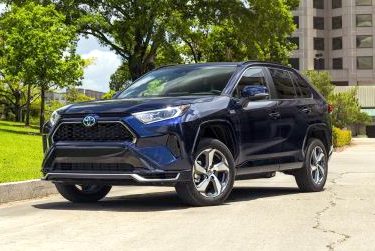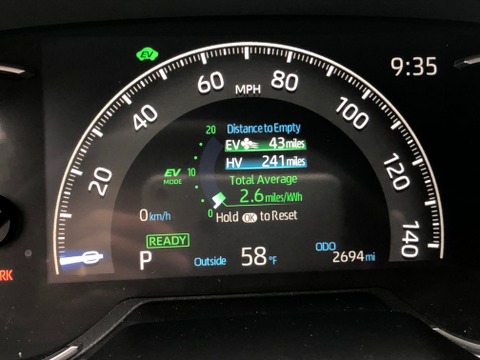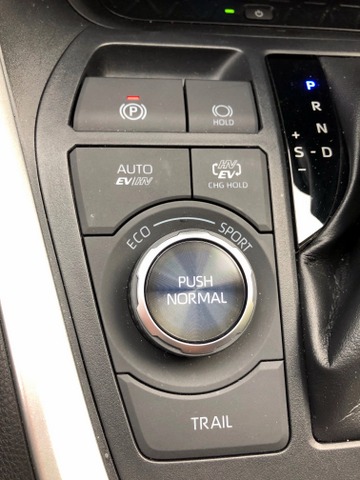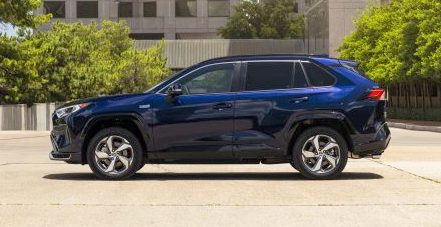Small Plug-in Crossover with Power and Range
Ed note: It’s not often that we have two contributors reviewing the same model almost back-to-back, but with a hot new model like the 2021 Toyota RAV4 Prime it was bound to happen. You’ll see each has his own perspective, which is what these reviews are all about. We welcome your takes as well in the comments. This is Steve’s take; Gary’s can be found here.

The compact crossover market is growing—becoming the heart of the auto business in the U.S.A. Toyota’s RAV4 has been a leader in the segment for years. For 2021, Toyota’s given its hybrid version a plug and a bigger battery, so it can serve as a pure-electric vehicle for local driving and an efficient gasoline-powered hybrid for long trips.
Plug-in hybrids are a transitional step to electrifying the fleet, with their blend of engine and motor plus a small chargeable battery. The 2021 Toyota RAV4 Prime, like the Prius Prime, enables 42 miles of EV range, which will likely serve most people’s daily needs. When they have to drive farther, the 2.5-liter four-cylinder gasoline engine kicks in.
I had a chance to test a Supersonic Red and Black 2021 RAV4 Prime XSE (my first 2021 test vehicle) for a week. For my pandemic-induced cautious visits to the grocery store and outdoor band rehearsal, the little SUV smoothly and silently negotiated residential streets and downtown main drags. When I wanted to visit my grandkids (they’re in my bubble), the 170-mile round trip brought the engine out of hiding.
Hearing the four-cylinder come to life makes you appreciate the splendid silence of the car during its EV times. On my family trip, I did get all the way from Castro Valley to Novato (about 45 miles) before the engine sprang to life, as advertised. Working through a continuously variable automatic transmission (CVT), the engine noisily pushes the revs higher when you’re climbing hills, as CVTs are known to do.
The Prime Stats
The 2021 Toyota RAV4 Prime is a real performer, with the engine and motor combining for 302 total horsepower—more than the regular RAV4; Toyota brags of 5.8-second zero-to-60 acceleration times. Not bad for a 4,300-pound, tall, four-door family car.

For EPA stats, the RAV4 Prime earns 94 MPGe when you charge up the battery and 38 MPG if you don’t (it acts like a regular hybrid). The EPA Green scores are a 7 for Smog and a perfect 10 for Fuel Economy and Greenhouse Gas. The engine emits just 72 grams of CO2 per mile and would be even lower if you drove the car locally on battery power most of the time.
The original RAV4 was pretty small when it arrived in 1995, but today it can accommodate a family of five without a problem, and the high roofline makes it feel airy. An hour and a half of seat time showed the car’s freeway finesse, and the well-padded, deeply bolstered chairs were delightful to relax in. The steering wheel is fat and leather-wrapped. All of the interior panels are padded, which conveys a more upscale feel, although this is no luxury cruiser.
In a masculine black and silver, with angular lines, the RAV4 interior conveys some of the truck feeling buyers seem to want while still behaving like a tall car in daily driving. The fat, rubber-coated control knobs on the center climate screen are easy to find and the tall center screen is modern and provides at-a-glance information.
Two Driving Modes

You can drive the RAV4 as an EV or a hybrid. In hybrid mode, you can save your battery power, for example, while on the freeway, so you can use it later in town. You can drive in Eco, Sport or Normal mode, controlled by a button on the center console. Eco saves gas, Sport is more fun, and Normal is where I left it. As a plug-in hybrid, the car is designed for frugality and environmental sensitivity, but with 302 horsepower, Sport might be just the thing when a curving rural two-lane road beckons.
The XSE features standard electronic on-demand all-wheel drive. It uses a second small electric motor on the rear axle to add traction and give extra hill-climbing performance off-road. Predictive Efficient Drive is a high-tech feature that works with the navigation system to evaluate where you’re going and regulate the charging and discharging of the hybrid battery for maximum electric range. All Toyota hybrids provide a screen showing energy flow. With the second motor, it’s pretty complicated in this new RAV4.
Charging the 18.1 kilowatt-hour battery is easy. Because this is plug-in hybrid, you’ll never have to visit a charging station if you don’t want to. At home, using standard 120V household current, you can expect to fill an empty battery in 4.5 hours. If you happen to have 240V level 2 charging handy, it’ll cut that to 2.5 hours. By the way, the added battery pack sits under the car, taking up no passenger or cargo space and providing a lower center of gravity for more stability.

The Prime comes as an SE or an XSE. My top-level XSE was loaded with standard equipment, and also featured premium audio, the Weather Package and the Premium Package. The premium audio system ($1,620) flaunts 11 JBL speakers, including a subwoofer and amplifier, entertaining during intercity jaunts. The Weather Package ($375) adds a heated leather-covered steering wheel and rain-sensing intermittent wipers. The Premium Package ($3,765) brings a 10-inch head-up display, panoramic glass roof, Softex (animal-free leather) seating, a power liftgate and lots more (see Toyota’s website for the long list). Toyota dings you $425 for the “special color” paint.
All this moves the car into Lexus pricing territory–$49,577—while still retaining a Toyota-level feel. Base prices are $38,100 for the XE and $41,425 for the XSE, plus $1,120 for the “delivery processing and handling fee.”
The RAV4 sits in choice territory in the auto market, and with the new Prime, can be an extremely clean and efficient option. While it isn’t as environmentally heroic as a pure electric model, depending on where and how much you drive, it can act a lot like one.
Story by Steve Schaefer; photos by Steve and the manufacturer.
Related Stories You Might Enjoy—Compact Crossovers with a Plug
Road Test: 2020 Hyundai Kona Electric
Road Test: 2020 Kia Niro Electric
Road Test: 2020 Kia Niro PHEV
News: Jeep Wrangler to Get PHEV in 2020
News: Jeep Renegade & Compass Go PHEV
Road Test: 2019 Mitsubishi Outlander PHEV
Flash Drive: 2020 Hyundai Nexo FCEV
Road Test: 2019 Subaru Crosstrek PHEV
News: Volvo XC40 Recharge EV Car of the Year Finalist
News: 2020 Kia Soul EV Debuts
News: 2021 Ford Mustang Mach-E Update
Road Test: 2020 Mini Cooper EV
Disclosure:
Clean Fleet Report is loaned free test vehicles from automakers to evaluate, typically for a week at a time. Our road tests are based on this one-week drive of a new vehicle. Because of this we don’t address issues such as long-term reliability or total cost of ownership. In addition, we are often invited to manufacturer events highlighting new vehicles or technology. As part of these events we may be offered free transportation, lodging or meals. We do our best to present our unvarnished evaluations of vehicles and news irrespective of these inducements.
Our focus is on vehicles that offer the best fuel economy in their class, which leads us to emphasize electric cars, plug-in hybrids, hybrids and diesels. We also feature those efficient gas-powered vehicles that are among the top mpg vehicles in their class. In addition, we aim to offer reviews and news on advanced technology and the alternative fuel vehicle market. We welcome any feedback from vehicle owners and are dedicated to providing a forum for alternative viewpoints. Please let us know your views at publisher@cleanfleetreport.com.

9 thoughts on “Road Test: 2021 Toyota RAV4 Prime”